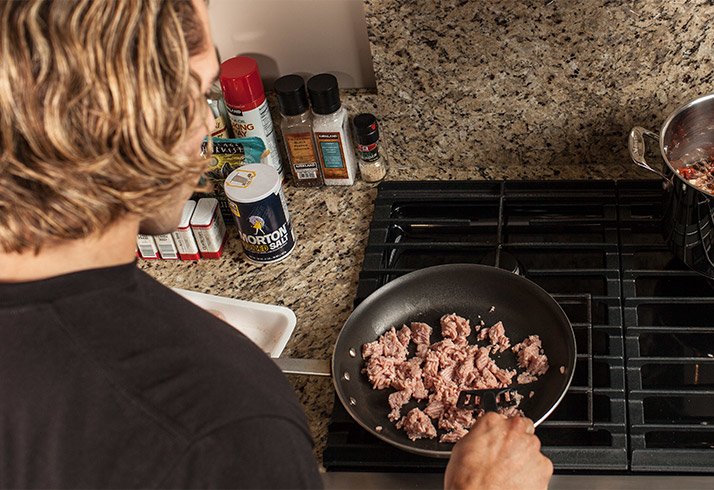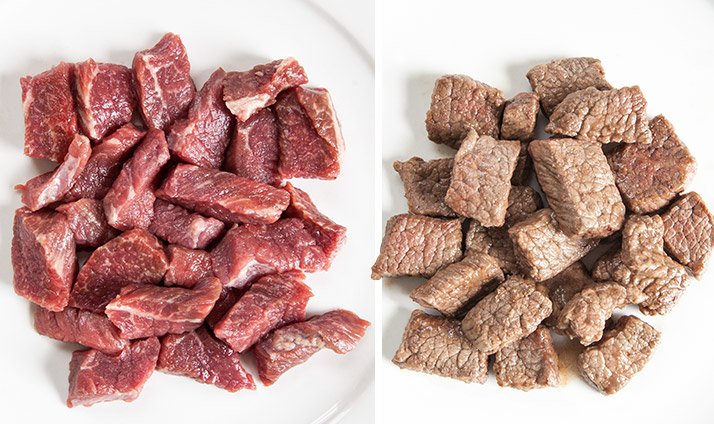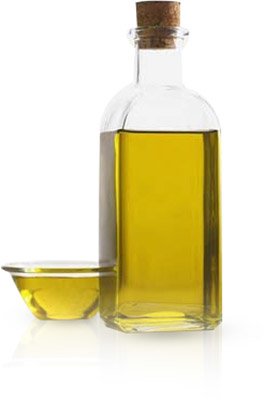
Are You Ruining Meat's Health Benefits By How You Cook It?
Meat is a protein-packed powerhouse, but you may be short-changing yourself when you prepare it. Don't let the cooking process rob you of your physique goals!
Picture this: You're standing over your stove, frying a few beautiful slices of bacon with an almost idiotic grin on your face, when—horror of horrors—your bacon starts to shrink! Your grin droops into a frown as the bacon before you withers into something skimpy and almost pitiful. Picking up your shrunken bacon, roughly half of its original size, you begin to quietly sob, tears dripping into the grease...
OK, that scenario might be a tad melodramatic, but we've all been there—without the crying, perhaps. Cooking cuts into the size of meats and high-protein meals, but that's not all that happens. Other changes take place during cooking that may impact your quest for gains.
Here's an athlete's guide to learning more about what happens when you cook your food. Use it to save time, calories, and even potential heartbreak!
Cooking and Portion Sizes
Deciding how much meat to buy for a week's worth of meals can be challenging. You don't want to run out of cooked proteins after two days—or have enough leftovers to feed a family of 10. Understanding the impact cooking has on your protein will help you avoid both situations.

When you cook meat, water and fat are lost as a result of cell breakdown and rearrangement of structural proteins. Depending on the cut of meat and the type of animal, the final yield is often much less than what you started with. If you prepare your meals ahead of time, knowing this will help you purchase enough protein to last you for the week.
This list from the United States Department of Agriculture (USDA) expresses final cooking yield as a percentage of original weight for a variety of protein options.1
Table 1 USDA Cooking Yields for Meat and Poultry
| Protein | Cooking method | Average cooking yield |
|---|---|---|
| Beef sirloin | Roasted | 84% |
| Pot roast | Braised | 64% |
| Flank steak | Grilled | 81% |
| High-fat ground beef | Pan-fried | 62% |
| Medium-fat ground beef | Pan-fried | 67% |
| Low-fat ground beef | Pan-fried | 73% |
| Beef tenderloin |
Roasted Grilled |
82% 80% |
| Chicken (breast, thigh and skin) | Roasted | 62% |
| Ground bison | Grilled | 77% |
| Ground venison | Grilled | 83% |
| Ground elk | Grilled | 84% |
| Lamb roast | Roasted | 74% |
| Pork loin | Roasted | 82% |
| Pork bacon |
Baked Microwaved Pan-fried |
32% 29% 87% |
| Whole ham rump | Roasted | 87% |
| Turkey (dark meat) | Roasted | 74% |
| Turkey (white meat) | Roasted | 68% |
It's important to keep in mind that these yields are averages based on a standardized cooking method that may or may not compare with how you prefer to cook your protein, but the numbers are still worth consideration.
For example, let's assume you need 4 ounces of cooked sirloin—which has a cooked yield of 84 percent—for 10 meals throughout the week, for a total of 40 ounces. Based on the chart, you'd divide 40 by 84 percent (40 / .84) to determine you must buy 48 ounces (3 pounds) of raw sirloin in order to meet your weekly portion goals.
Using this chart as a quick reference will help ensure you purchase a near-perfect amount of protein at each grocery trip. Always err on the side of more to make sure you have enough!
Cooking and Caloric Intake
It's important to understand the effect cooking has on total fat and calories, especially if you're a calorie counter. Depending on your cooking method, you may end up eating more—or fewer—calories than you'd planned on at each meal.
Alas, the nutrition labeling of meat lacks uniformity. The USDA, which oversees various types of meat, doesn't specify whether nutrition facts should be posted for raw or cooked portions. Additionally, fish, which is governed by the Food and Drug Administration (FDA), doesn't require labeling for fresh seafood at all.
For most cuts of meat, the nutrient profile and serving size of protein is often recommended on the basis of grams or ounces in the raw state. But, as you know, a raw 8-ounce sirloin looks nothing like its original self after it's been grilled. This poses a concern for people who don't know if they should track food in the raw or cooked state. You can actually do either, as long as you're consistent.

Don't fret too much over these concerns, though. A study out of the Journal of Meat Science examined the impact of various cooking methods on multiple cuts of meat.2 Regardless of which cooking method was used, each cut of meat significantly lost both calories and fat, but not protein.
Table 2 Average Fat and Calorie Content Change with Cooking2
Raw
| Protein | Serving Size (oz.) | Fat (g) | Calories |
|---|---|---|---|
| Sausage | 3.5 | 22 | 290 |
| Steak | 3.5 | 17.5 | 228 |
| 100% beef patty (70/30) | 3.5 | 25 | 297 |
Cooked*
| Protein | Serving Size (oz.) | Fat (g) | Calories |
|---|---|---|---|
| Sausage | 2.7 | 16.5 | 242 |
| Steak | 2.6 | 14 | 195 |
| 100% beef patty (70/30) | 2.5 | 15.5 | 216 |
*Cooking methods used included grilling, roasting, pan-frying, and a light boil-frying combination.
Differences
| Protein | Serving Size (oz.) | Fat (g) | Calories |
|---|---|---|---|
| Sausage | -22% | -5.5 | -48 |
| Steak | -27% | -3.5 | -33 |
| 100% beef patty (70/30) | -28% | -9.5 | -81 |
Is your head spinning yet? Just remember that the cooking process reduces fat content, and fattier cuts tend to lose more weight. You don't lose much protein, however, by cooking.
Cooking and Added Fat

If you cook your meat without adding additional fat like olive oil or butter, you may be able to buy a slightly fattier and cheaper cut of meat. Fattier cuts tend to lose more fat than leaner cuts, so you can save a few dollars at the store while still keeping your fat macros in check.
On the other hand, cooking a lean meat with added fat may actually increase the total fat content. A study in the Journal of Meat Science found that a low-fat burger (90/10) lost a half gram of fat when grilled, but gained 3.5 grams when cooked in vegetable oil.2
When trying to gain or lose weight, knowing how many calories you eat is critical. Because fats like olive oil and butter are so calorie-dense, you should track them whenever you use them. Opt for a low-calorie cooking spray if you're concerned with extra fat calories sneaking into your meals.
In the end, as long as you track your foods consistently, there's no need to change your methodology. You can weigh your food raw or cooked—just pick one method, and stick with it!
References
- USDA Table of Cooking Yields for Meat and Poultry (2014). http://www.ars.usda.gov/Main/docs.htm?docid=9448.
- Sheard, P.R., Nute, G.R. & Chappell, A.G. (1998). The Effect of Cooking on the Chemical Composition of Meat Products with Special Reference to Fat Loss. Journal of Meat Science, 49(2), 175-191.
